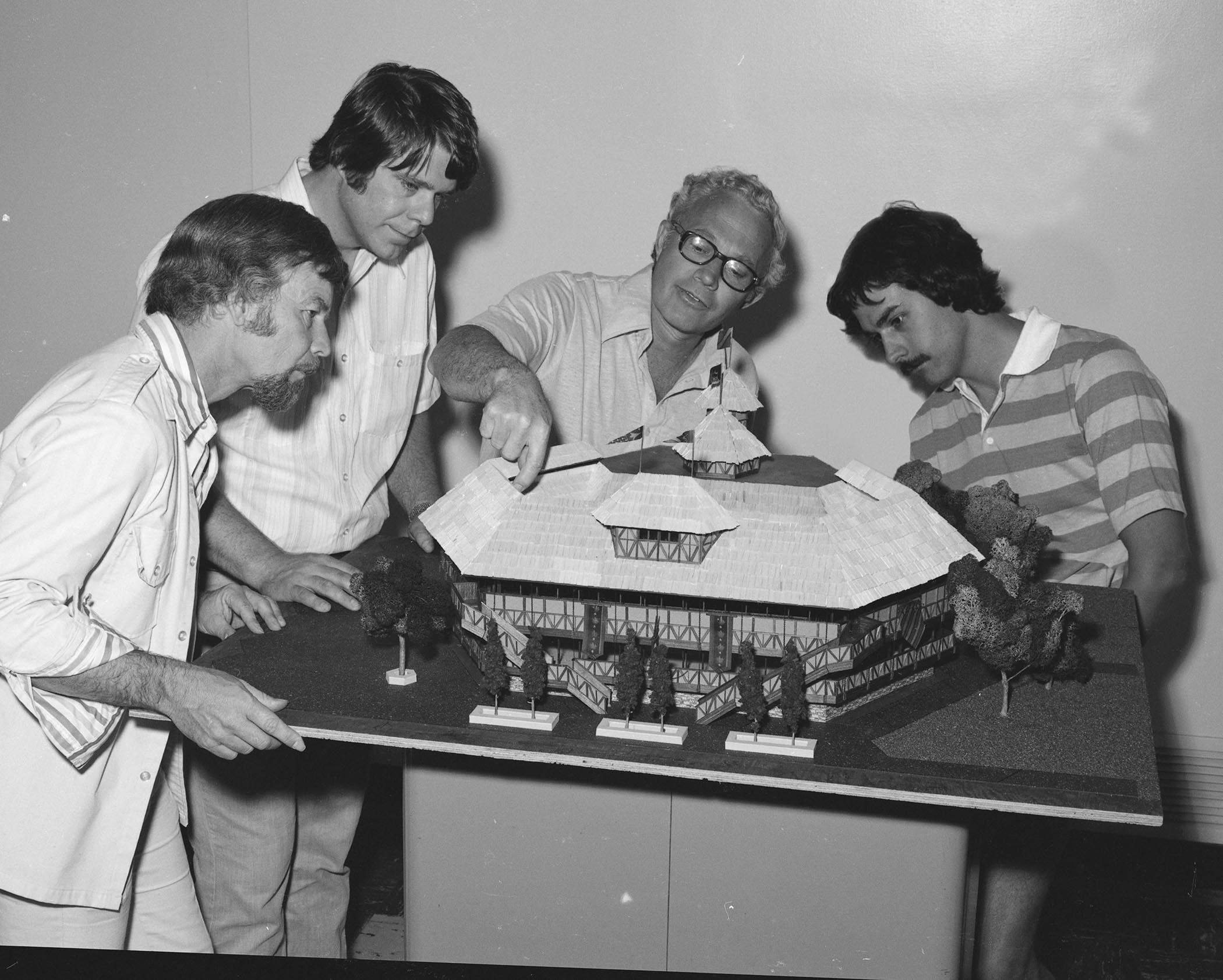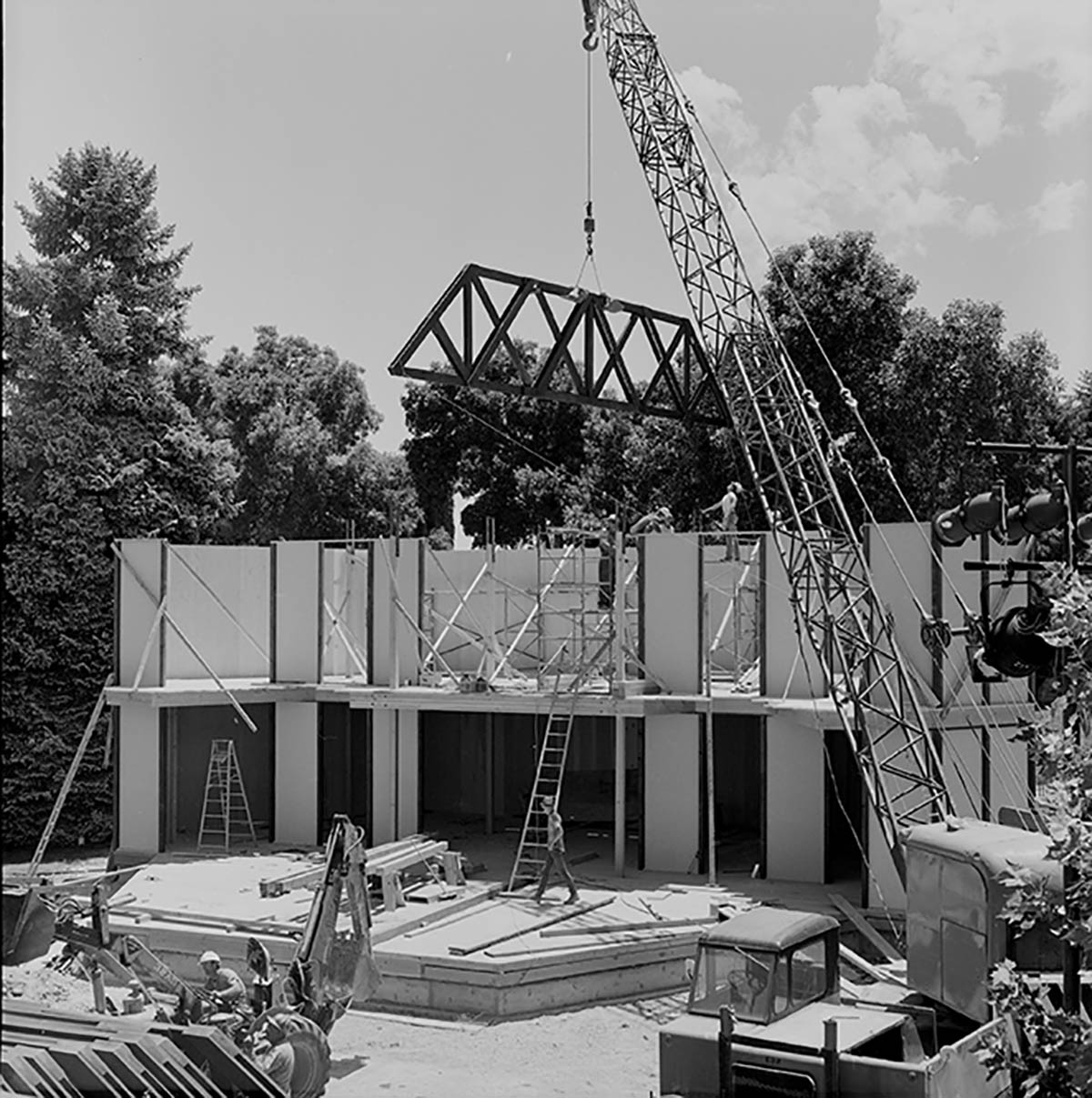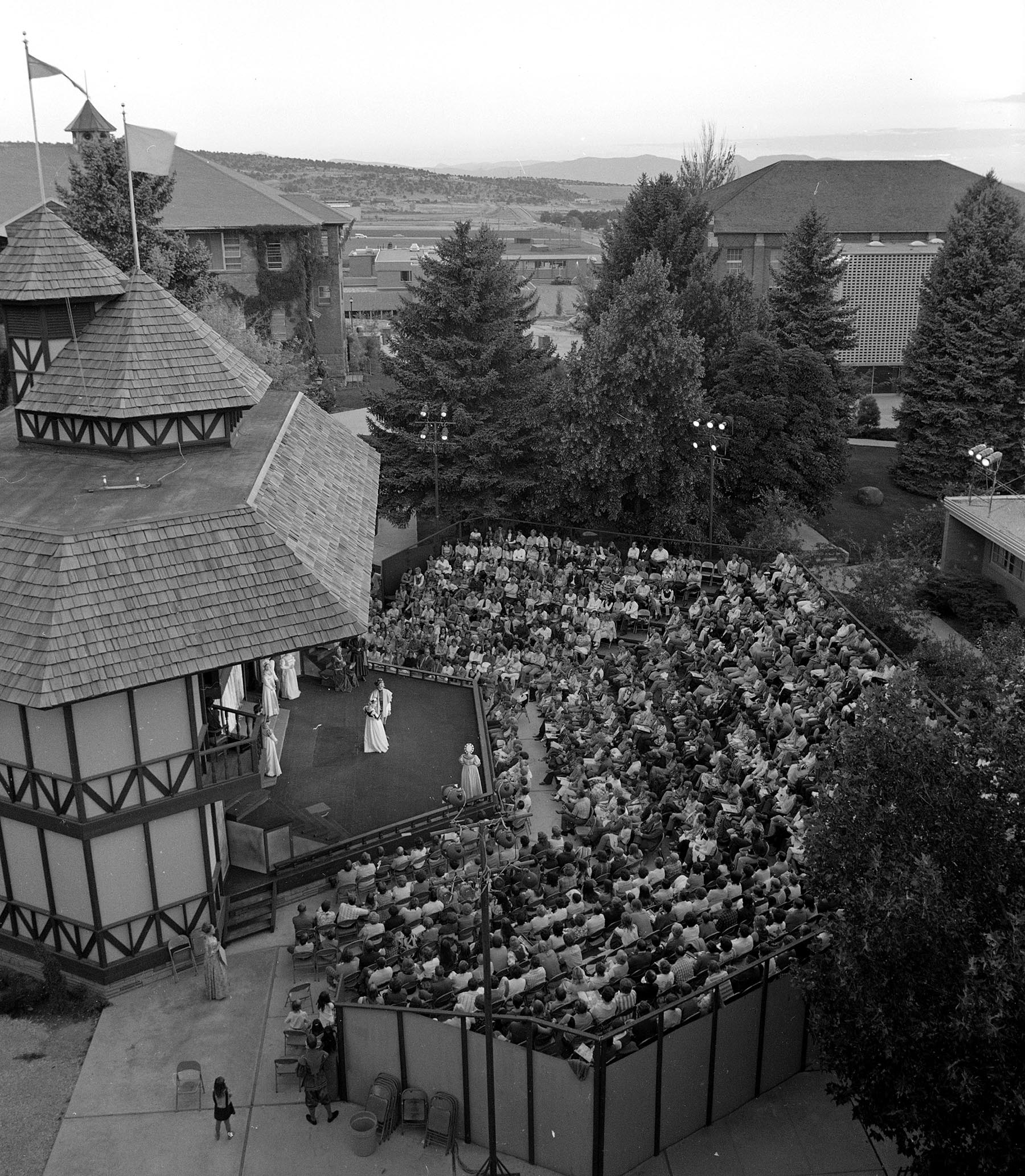Red Rocks and the Wooden O



Red Rocks and the Wooden O
By Ryan D. Paul
William Shakespeare, in the prologue to Henry V referred to the stage as an “unworthy scaffold.” In the early days of Elizabethan theatre, traveling troupes would erect crude scaffolds and place planks over them to create a quick stage. In 1962, with its inaugural performance of The Taming of the Shrew, the Utah Shakespeare Festival continued this tradition—rolling out construction materials and production equipment in the summer and taking them down at the close of the season. However, by 1969 the ravages of time and the elements were obvious. An increasing amount of money and effort was spent each year in repairing or replacing parts of the stage. After a decade of operation the Festival needed a permanent home. This new theatre, nestled within the red rocks of southern Utah and soon to be named the Adams Memorial Shakespearean Theatre, would launch the Festival into a new era of production and itself would be a character in every performance. The “unworthy scaffold” would become the “wooden O” for this young Shakespeare company.
Douglas N. Cook had joined the Festival in 1964. While teaching drama at the University of California at Riverside, he had heard of the new Shakespeare festival in Cedar City from his friend Michael Addison, and he became intrigued. Addison had worked as a director for the Festival in 1963 and recognized that Cook would be a strong addition to the creative team. Festival Founder Fred C. Adams welcomed Cook with open arms. Cook was especially adept at designing scenery for Shakespeare productions. Under Cook’s guidance, the props department blossomed, and the sets better reflected the periods that designers were trying to represent. At the conclusion of the 1969 season, Doug and his wife, Joan, decided to remain in Cedar City for a few more weeks while Doug applied his talent for design to work up some rough sketches for a new outdoor theatre space.
Cook had been doing research into the major elements of many Elizabethan theatres. While no blueprints of Shakespeare’s Globe existed, many other designs of similar spaces were available. During the company’s first ten years, Adams and the Festival production teams had experimented with various stage locations and had discovered the most desirable spot. With location settled, Cook was able to design the new theatre to fit within very specific dimensions.
Based upon his research, Cook knew that the new theatre would need to have three essential elements. First, it must have a thrust stage (this meant that the performance space would be surrounded on three sides by seats); second, it must have a gallery or multi-level seating; and, third, it must be open to the air. All of these designs were in every major Elizabethan theatre of Shakespeare’s day and would be necessary for the Festival’s new space. Cook and Adams understood that the space defines the play, that producing the works of Shakespeare in a space similar to that in which they would have originally been performed would assist in transporting the audience into another world. This theatre would become a character itself. Everything the Utah Shakespeare Festival had learned about producing the Bard would go into the design of the theatre.
With designs in hand, Adams now began the search for financial support. In an early proposal to the College of Southern Utah (now Southern Utah University), Adams argued that the new theatre could be used for a variety of purposes, including “band concerts, dance reviews, lectures, road show competitions, out-of-door movies, school assemblies, Easter sunrise services, pep rallies, astronomy classes, and commencement.” Although the college agreed with the need for a space like the one Adams proposed, they could not meet the financial needs of the project.
Adams, then turned to private funding sources. He achieved success when three generous donors, Dr. Obert C. and Grace Adams Tanner, Sadie Barnard, and Dean B. Eggertson agreed to fund the bulk of the project. Additionally, the theatre would now be dedicated to the parents of Mrs. Tanner, Thomas and Luella Adams, and be known as the Adams Memorial Shakespeare Theatre—lovingly referred to now as the Adams Theatre.
Under the direction of Max Anderson, an architect for the State of Utah building board, who worked on the project on a pro bono basis, the outdoor theatre began to take shape. The theatre would be constructed in phases, beginning with the tiring house and then the seating area. Technical and electrical planning also factored heavily into the design of the Adams Theatre. Cameron Harvey (later a producing director at the Festival) worked tirelessly to design a state-of-the-art lighting and sound system that would be unnoticeable to the audience but enhance the performance. The technical and physical design of the Adams Theatre would help establish it as one of the most talked about theatres in the country.
In 1977 the Adams Theatre was complete. The tiring house had been finished a few years earlier; and, despite being called upon to remove the construction scaffolding just forty-five minutes before the first performance, the actors loved the new stage. Utah Shakespeare Festival guests soon fell in love with the new space and validated its existence with sold out performances. In 1981, the British Broadcasting Company searched the world for a proper space to produce a series of theatre programs and found the Adams Theatre to be a perfect spot to focus on the Elizabethan period of world theatre. They added further acclaim by announcing “there’s not a theatre like this in England, Asia, or Europe.”
Tragedy nearly befell the Utah Shakespeare Festival when on February 25, 2000, fire consumed much of the light and sound booth and part of the roof of the Adams Theatre. The blaze was quickly contained and the damage was repaired by opening night in June. The theatre had escaped the fate of Shakespeare’s original Globe Theatre, which was completely destroyed by fire during a production of Henry VIII in 1613. Most recently, in 2011, the Adams Theatre hosted its first ever live broadcast. In partnership with BYUtv, the Utah Shakespeare Festival sent its production of A Midsummer Night’s Dream over the airwaves. This collaboration, which lead to an Emmy Award for BYUtv, further cemented the Festival and the Adams Theatre’s place in the popular culture of Utah.
Now, like a great battleship, the Adams Theatre is soon to be decommissioned. The mighty Wooden O has served its purpose in enriching, entertaining, and educating the lives of those who sat in her seats and witnessed her bounty. Like the stage before, the passage of time and changing technology have taken their toll. The new Engelstad Shakespeare Theatre is already rising and a new Wooden O will stand guard over the works of the Bard and serve as an anchor for the Utah Shakespeare Festival’s future. The Engelstad Shakespeare Theatre will provide an amazingly rich theatrical experience for Utah Shakespeare Festival audiences. While preserving the character and up close and personal style of the Adams Theatre, the Engelstad Theatre will be located closer to the Randall L. Jones Theatre, have additional restrooms (always a plus), and be ADA accessible. This new theatre is the next step in further elevating the capacity of the Utah Shakespeare Festival to continually produce artistic, relevant, and meaningful productions of William Shakespeare’s work.
Hundreds of thousands of people have made the Adams Theatre part of their story and hundreds of thousands more will discover Shakespeare and themselves at the Engelstad Theatre. If William Shakespeare is to be believed that “what’s past is prologue,” an amazing future it will be.







